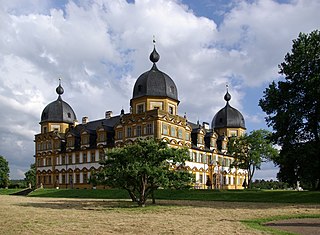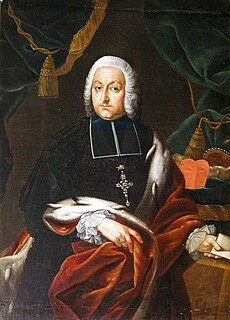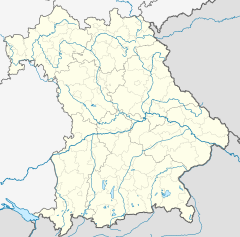
Neuschwanstein Castle is a 19th-century historicist palace on a rugged hill above the village of Hohenschwangau near Füssen in southwest Bavaria, Germany. The palace was commissioned by King Ludwig II of Bavaria as a retreat and in honour of Richard Wagner. Ludwig chose to pay for the palace out of his personal fortune and by means of extensive borrowing, rather than Bavarian public funds. Construction began in 1869, but was never fully completed.

Ludwigsburg Palace, nicknamed the "Versailles of Swabia", is a 452-room palace complex of 18 buildings located in Ludwigsburg, Baden-Württemberg, Germany. Its total area, including the gardens, is 32 ha – the largest palatial estate in the country. The palace has four wings: the northern wing, the Alter Hauptbau, is the oldest and was used as a ducal residence; the east and west wings were used for court purposes and housing guests and courtiers; the southern wing, the Neuer Hauptbau, was built to house more court functions and was later used as a residence.

The Schenk von Stauffenberg family is a noble (Uradel) Roman Catholic family from Swabia in Germany. The family's best-known recent member was Colonel Claus Schenk Graf von Stauffenberg – the key figure in the 1944 "20 July plot" to assassinate Adolf Hitler.

Solitude Palace is a Rococo schloss and hunting retreat commissioned by Charles Eugene, Duke of Württemberg. It was designed by Johann Friedrich Weyhing and Philippe de La Guêpière, and constructed from 1764 to 1769. It is located on an elongated ridge between the towns of Leonberg, Gerlingen and Stuttgart in Baden-Württemberg.

Lothar Franz von Schönborn-Buchheim was the Archbishop-Elector of Mainz from 1694 to 1729 and the Bishop of Bamberg from 1693 to 1729. As Archbishop of Mainz, he was also Archchancellor of the Holy Roman Empire. Lothar Franz von Schönborn is known for commissioning a number of Baroque buildings, such as the palace Schloss Weissenstein.

Baunach is a town in the Upper Franconian district of Bamberg and the seat of the administrative community (Verwaltungsgemeinschaft) of Baunach. Until administrative reform in 1972, Baunach belonged to the Lower Franconian district of Ebern.

Schloss Weißenstein is a Schloss or palatial residence in Pommersfelden, Bavaria, southern Germany. It was designed for Lothar Franz von Schönborn, Prince-Bishop of Bamberg and Archbishop of Mainz, to designs by Johann Dientzenhofer and Johann Lukas von Hildebrandt. Weißenstein, built as a private summer residence, remains in the Schönborn family. It is considered a masterwork of Baroque architecture.

Memmelsdorf is a community in the Upper Franconian district of Bamberg bordering in the west directly on the city of Bamberg.

Pommersfelden is a community in the Upper Franconian district of Bamberg in Germany.

Schloss Johannisburg is a schloss in the town of Aschaffenburg, in Franconia in the state of Bavaria, Germany. It was erected between 1605 and 1614 by the architect Georg Ridinger for Johann Schweikhard von Kronberg, Prince Bishop of Mainz. Until 1803, it was the second residence of the Prince Bishop of Mainz. It is constructed of red sandstone, the typical building material of the Spessart, the hills near Aschaffenburg.

Schloss Kirchheim is a castle and palace in the old town of Kirchheim unter Teck, in the German state of Baden-Württemberg. The palace was built in the 16th century by Ulrich, Duke of Württemberg as a castle and part of a greater system of defensive works. Over two centuries later, it became the dower house for the Duchy and later Kingdom of Württemberg. The palace's interior is currently arranged and furnished as it was during the residence of its final dowager, Henriette von Nassau-Weilburg.
Count Franz-Ludwig Schenk von Stauffenberg is a German lawyer and politician from the CSU. He was a member of the Bundestag from 1976 to 1987 and of the European Parliament from 1984 to 1992. He is the son of World War II colonel and resistance leader Claus von Stauffenberg.

Marquard Sebastian Schenk von Stauffenberg was the Prince-Bishop of Bamberg from 1683 to 1693.

Johann Philipp Anton Freiherr von und zu Franckenstein, born in Forchheim on 27 March 1695, appointed in 1743 as Vicar-General of Mainz, was from 1746 to 1753 ruling Prince-bishop of Bamberg.

Schloss Greifenstein is a castle in the mountainous Fraconian Switzerland region of Upper Franconia, Germany. Since 1691 Greifenstein, the "stone stronghold" of Heiligenstadt round its walls, is the seat of the noble Schenk von Stauffenberg family. Greifenstein is a prominent feature of the modern tourist itinerary called the Burgenstraße.

Residenz Ansbach, also known as Markgrafenschloß, is a palace in Ansbach, Germany. It was the government seat of the Margrave of Brandenburg-Ansbach. Today it is the administrative seat of the government of Middle Franconia. The Great Hall and the Orangerie in its garden serve as venues for the biennial music festival Bachwoche Ansbach.

Schloss Weimar is a Schloss (palace) in Weimar, Thuringia, Germany. It is now called Stadtschloss to distinguish it from other palaces in and around Weimar. It was the residence of the dukes of Saxe-Weimar and Eisenach, and has also been called Residenzschloss. Names in English include Palace at Weimar, Grand Ducal Palace, City Palace and City Castle. The building is located at the north end of the town's park along the Ilm river, Park an der Ilm. It forms part of the World Heritage Site "Classical Weimar", along with other sites associated with Weimar's importance as a cultural hub during the late 18th and 19th centuries.

Schönbusch is a historic park and Schloss near the town of Aschaffenburg in the Franconia region of Bavaria, Germany. The park was designed in the late 18th century as an English landscape garden for an Archbishop of Mainz. Various Neoclassical buildings, including the Schloss are scattered across the park. It is open to the public.

Bruchsal Palace, also called the Damiansburg, is a Baroque palace complex located in Bruchsal, Germany. The complex is made up of over 50 buildings. These include a three-winged residential building with an attached chapel, four pavilions separated by a road, some smaller utility buildings, and a garden. It is noted for its fine Roccoco decoration and in particular its entrance staircase, which is regarded as one of the finest examples of its kind in any Baroque palace.





















